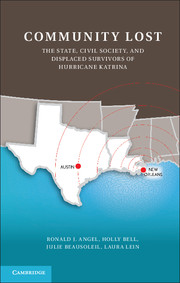Book contents
- Frontmatter
- Contents
- Acknowledgments
- Introduction
- 1 After the Storm
- 2 An Emerging Methodology for a Crisis Situation
- 3 Life before the Storm
- 4 Evacuation and Arrival in Austin
- 5 The Limited Transportability of Social Capital
- 6 Civil Society, NGOs, and the Grassroots Response
- 7 Housing, Employment, and Identification
- 8 Health Care and the Limitations of Civil Society
- 9 The State, Civil Society, and the Limitations of Social Capital
- Bibliography
- Index
Introduction
In the Shadow of T. H. Marshall – Social Capital, Social Rights, and Sources of Vulnerability among Low-Income and Disadvantaged Groups
Published online by Cambridge University Press: 05 June 2012
- Frontmatter
- Contents
- Acknowledgments
- Introduction
- 1 After the Storm
- 2 An Emerging Methodology for a Crisis Situation
- 3 Life before the Storm
- 4 Evacuation and Arrival in Austin
- 5 The Limited Transportability of Social Capital
- 6 Civil Society, NGOs, and the Grassroots Response
- 7 Housing, Employment, and Identification
- 8 Health Care and the Limitations of Civil Society
- 9 The State, Civil Society, and the Limitations of Social Capital
- Bibliography
- Index
Summary
HURRICANE KATRINA AND THE SOCIAL CONSTRUCTION OF DISASTER
After living through one of the largest storms of the century, on the morning of August 29, 2005, the residents of New Orleans, Louisiana, appeared to be safe. Within hours, though, the seriousness of the situation became clear as the storm surge breached the levee system that protected the city and submerged large areas, including many low-lying and low-income neighborhoods. More than a million individuals were forced from their homes, many never to return. Many lost family members, and many more lost their homes, their possessions, and all ties to their old neighborhoods and communities. The human tragedy that unfolded in the media riveted the nation’s attention. In response to the massive suffering, communities in Texas and elsewhere responded generously. By September 4, more than 250,000 hurricane victims had evacuated to Texas (Embry, 2005). Houston provided shelter and emergency services to approximately 150,000 evacuees (Berger, 2006). Other large cities, including San Antonio, Dallas, and Fort Worth, hosted additional thousands. During the weekend of September 2, the Austin Convention Center opened its doors to between five thousand and seven thousand evacuees, and many others were sheltered elsewhere in the city (Humphrey & Fitzsimmons, 2005; Wynn, 2006). Many of these survivors of the storm began a long diaspora during which they attempted to rebuild their lives in the new city. In this book, we tell the story of those victims of the storm who remained in Austin for long periods and their attempts to return to normal and build new lives in a new and strange city.
As their stories reveal, the challenges they faced were daunting. Most of those who did not return had lived in low-income communities in New Orleans, and many had not owned their homes. Between 2005 and 2007, half of the population of New Orleans consisted of renters (U.S. Census Bureau, 2005–7). For renters and owners alike, though, the storm destroyed the very basis of their daily security. Disasters exacerbate problems of housing affordability because they reduce the inhabitable housing stock (Comerio, 1998). Estimates suggest that more than 140,000 housing units were damaged or destroyed in New Orleans, including more than 73 percent of all low-rent units (National Low-Income Housing Coalition, 2005).
- Type
- Chapter
- Information
- Community LostThe State, Civil Society, and Displaced Survivors of Hurricane Katrina, pp. 1 - 16Publisher: Cambridge University PressPrint publication year: 2012



